Ryan Hall's Blog, page 361
August 26, 2015
Three American Men Advance To World 5000m Finals
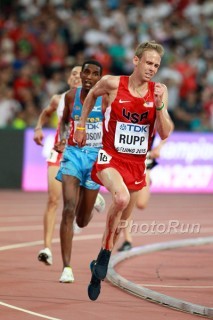
Galen Rupp, shown here in the 10,000m final earlier this week, survived a rough and tumble 5,000m prelim to advance to Saturday's final. Photo: PhotoRun.net
(c) 2015 Race Results Weekly, all rights reserved. Used with permission.
BEIJING—Double Olympic gold medalist Mo Farah of Great Britain survived not one, but two tripping incidents in his 5000m preliminary heat on Wednesday at the 15th IAAF World Championships in Athletics at National Stadium.
Running in the second of two heats with his American training partner Galen Rupp, Farah was first tripped 6 minutes and 48 seconds into the race with 6 laps to go, nearly falling. Five laps later, he tangled with Canada’s Mohamed Ahmed with just 180 meters to go, pitching forward but again managing to stay on his feet. He went on to finish second to Ethiopian teenager Yomif Kejelcha in 13:19.44.
Since Farah’s heat was much faster than the first—won by Ethiopia’s Hagos Gebrehiwet in a pedestrian 13:45.00—Farah knew he could have fallen, gotten up, and still qualified on time.
“I was thinking, even if I went down at that point, I looked at the laps and I knew (what) we had to run, if I run 75 (seconds) I’d still qualify,” he told reporters. “I felt all right. I felt good. Just have to recover now.”
After the incident, Ahmed was disqualified under IAAF rule 163.2 (pushing, obstruction or jostling). But, Athletics Canada appealed, their appeal was successful, and Ahmed’s result was allowed to stand: third place in 13:19.58.
Farah pointed out that because he has a long, loping stride, he is often clipped by other runners, even in practice. He said it’s just part of racing.
“Somebody just caught my leg,” he explained. “You know, the way I run I just have long strides. I don’t blame anyone. Even in training, sometimes like with training partners, they touch my legs. It just happens. That’s why sometimes I have to be at the front, not the back.”
Rupp left the track bleeding from his shins with multiple spike wounds, but still qualified on time in eighth place in 13:20.78. Rupp wasn’t surprised by the sloppy running in his heat.
“I’m one of the bigger guys in there so it’s a little easier for me to hold my ground, I think,” he said. “It’s just to be expected.”
Also advancing from Team USA were Ryan Hill and Ben True.
Farah is looking to win his third consecutive 5000m world title, while also trying to duplicate his double-gold medal performance from these championships in Moscow in 2013. He said now he just needed to lay low and recover in advance of Saturday’s final.
“I just have to get in the ice bath now, two days in my room, playing PlayStation, chilling out.”
In the first round of 800m qualifying for women, American Alysia Montano—six times the USA champion in the two-lap event—wasn’t as lucky as Farah. She tangled with another runner with a little more than 200 meters to go in her heat, tumbling to the track. Although she was able to get up, she finished a distant seventh in 2:09.57. United States Track and Field lodged a protest, but it was denied by officials. Her world championships are over.
“It happened really quick,” a stunned Montano said moments after leaving the track. “It was just a little clip. I’m not sure. When we all started to move, I don’t know. It happened so fast. Honestly, I just have to figure it out. I’m just pretty bummed out right now.”
Montano’s American teammate, Brenda Martinez, the bronze medalist from Moscow in 2013, got boxed-in in the homestretch and struggled to clinch the third and final qualifying position from her heat.
“I made the biggest mistake,” said Martinez, looking slightly embarrassed. “I settled behind, and a space did not open at all until maybe 100 meters to go. The whole time I was licking my chops. When I finished, I was like, I’m not even tired. Like I shouldn’t be racing like that. I’m a little disappointed in myself.”
Other women’s 800m medal favorites advanced without incident, including Marina Arzamasova of Belarus, Lynsey Sharp of Great Britain, reigning champion Eunice Sum of Kenya, and Selina Büchel of Switzerland.
The post Three American Men Advance To World 5000m Finals appeared first on Competitor.com.
August 25, 2015
Workout Of The Week: Descend The Ladder

This challenging speed workout will help prepare you for the rigors of 5K/10K racing. Photo: Shutterstock.com
While half marathons and marathons are a matter of resisting fatigue during the later miles, 5K and 10K racing is like fighting off a lactic acid firestorm for the final third of the race.
No matter how comfortable the early pace may feel to you, about two thirds of the way into a fast 5K or 10K a spark suddenly catches fire and starts to spread rapidly as your legs begin to lock up and your stride shortens ever so slightly. Your quads are screaming at you to stop and your upper body tenses up as you seemingly start going backward while you struggle to maintain pace or stick with the runner in front of you.
There’s nothing wrong with any of this at the end of a hard race, of course; it simply means that you’re doing it right. While your muscles are inevitably going to catch fire toward the end of a competitive 5K or 10K effort, you can train your body to slow down the burn and better handle the demands of the race in training. One of my favorite ways to do this is with the descending ladder workout.
RELATED: How To Develop Speed For A Fast 5K
Begin by warming up with 15 to 20 minutes of easy jogging followed by six 20-second strides to get your fast twitch muscles firing. After your warmup is complete, run for 10 minutes at your current half-marathon race pace. If you’ve never raced a half marathon and are unsure of how fast to run this part of the workout, add about 15 seconds per mile to your 10K race pace or 30 seconds per mile to your 5K pace. The McMillan Calculator is also a handy tool that can help get you in the ballpark. The goal here is to inject some fatigue into your legs without totally wiping you out just yet.
After running 10 minutes at half marathon pace, jog slowly for 5 minutes as recovery. Once those five minutes are up, begin a descending ladder of pickups, starting with 6 minutes at your goal 10K pace—no faster. Upon completion of the 6-minute pickup, jog for 3 minutes as recovery. Continue to step down the ladder with faster pickups of 5 minutes at 10K race pace, 4 minutes at 5K race pace, 3 minutes @ 5K race pace, 2 minutes at 3K race pace (roughly 15 seconds per mile faster than your 5K pace) and, finally, 1 minute at 1-mile race pace. The recovery between each pickup is an easy jog for half the duration of the preceding interval, so 2:30 after the 5-minute pickup and so forth.
Another way to perform this workout is by doing specific intervals on the track. Perform the same warmup described above, followed by 10 minutes of running at your half-marathon race pace (preferably off the track). After jogging easily for 5 minutes to recover from that effort, step onto the oval and begin with 2,000 meters (5 laps) at your 10K race pace. Jog easily for half the duration it took you to complete that opening interval on the track and then run 4 laps at the same pace. Continue stepping down the lap ladder (3 laps, 2 laps, 1 lap), increasing the intensity with each repetition to the point where you’re running faster than your goal 5K race pace for the final two intervals. The recovery between each faster interval should be half the time of one you just completed.
This session is tough, but then again 5K/10K racing is too, so if you want to simulate the burning your legs are going to feel in the final mile or two of a race, then try descending the ladder in your next workout!
The post Workout Of The Week: Descend The Ladder appeared first on Competitor.com.
How Runners Can Improve Foot Strength
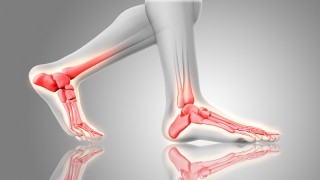
The feet are an important link in the kinetic chain that we sometimes forget about. The foot is a dynamic structure that needs to be strong and stable while also being soft and malleable. Thanks to its design and muscular attachments, it can store and utilize elastic energy with each footstrike. The strength and stability of the arch, referred to as the “foot core,” are required for proper foot function.
Both local and global muscles control the shape and function of the arch. The local muscles are primarily stabilizers known as the intrinsic foot muscles and are smaller in cross-sectional area. The global muscles are primarily prime movers of the foot and are larger in cross-sectional area. With each footstep and running stride, the local foot stabilizers function to control the amount and speed of arch deformation. Dysfunction of these muscles can result in an unstable arch and abnormal foot movement. Excessive deformation of the foot has been linked to plantar fasciitis and other lower limb injuries.
Traditional foot strengthening exercises usually involve curling the toes to pull a towel toward you or picking up marbles with your toes. These types of exercises will target the local foot muscles but will also involve the global muscles. Ideally “foot core” training should only target the local foot stabilizer muscles.
Enter the short foot exercise.
The goal of the short foot exercise is to “shorten” the foot by contracting the intrinsic muscles to raise the medial longitudinal arch, or in science-speak, pulling the first metatarsophalangeal joint toward the calcaneus (heel bone). Care should be taken to ensure the foot is in neutral alignment and that the toes are not flexed or extended. The short foot exercise is best learned seated and can be progressed to bilateral standing, single-leg standing then to functional activities such as squats, deadlift, lunges and hops. It should also be noted that being completely barefoot would enhance sensory input detection from the plantar surface of the foot and help you develop the sense of creating the short foot posture.
Your Arch Strengthening Routine
This routine consists of some exercises that can be performed daily (e.g. short foot, toe splaying and big toe presses) and exercises that can be performed 2-3 times per week (e.g. leg swings and calf raise to big toe press).
Short Foot Exercise
Sit in a chair in your bare feet. Form a 90-degree angle at your knees and ankles. Without crunching your toes, try to shorten your foot by doming the arches in your feet. You can focus on one foot at a time or do both at once. Try not to curl or extend your toes and keep your foot neutral. It’s harder than you think! Practice this throughout the day. You can even practice while sitting at your desk. Once you become competent in performing the short foot sitting, attempt the exercise standing on two legs then on one leg. (See an image here)
Toe Splaying
Try moving your toes away from each other but be careful not to curl or extend them. Practice throughout the day.
Big Toe Presses
Press your big toe into the floor while extending your other four toes. Hold each press for 8 seconds and perform 12-15 reps per foot.
Leg Swings
Dissimilar to dynamic leg swings that are commonly performed with a large amplitude, these legs swings are performed with a small amplitude to challenge your balance and hip and ankle stability. Stand on one leg in your bare feet and attempt to create the short foot posture. Swing the non-stance leg forward and backward 15 times. Without rest, swing the same leg left and right in front of your stance leg, also 15 times. Repeat this sequence without resting, then repeat on your opposite leg.
Calf Raise to Big Toe Press
Stand on the edge of a stair in your bare feet. Let your heels drop below the level of the stair. Then perform a traditional calf raise, but then proceed and press onto your big toe. This part is difficult for most. Feel free to hang on to something for balance. Perform 12-15 reps.
* * *
About the Author:
Jon-Erik Kawamoto, MSc, CSCS, CEP is a runner, strength coach and Managing Director of JKConditioning in St. John’s, NL, Canada. He specializes in strength training endurance athletes and is currently in the middle of preparing a strength training resource for runners. Stay in touch by checking out www.JKConditioning.com and finding him on Twitter at @JEKawamoto.
References
McKeon, P.O., Hertel, J., Bramble, D., & Davis, I. (2015) The foot core system: a new paradigm for understanding intrinsic foot muscle function. Br J Sports Med, 49, 5, 290. doi: 10.1136/bjsports-2013-092690
The post How Runners Can Improve Foot Strength appeared first on Competitor.com.
Photos: Beer and Running in Chattanooga, Tenn.
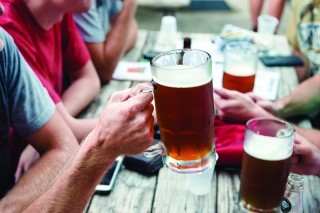
Situated along the Tennessee River and nestled among a portion of the Appalachian Mountains, the city of Chattanooga is beginning to boast an active community of runners and a growing reputation for their local craft beers. Thus, it’s only natural that one of the largest free social beer running clubs (with 16 locations across the nation), Running for Brews, has established a chapter in the Scenic City. In the past few years, the group has grown to a solid attendance of 30 to 40 runners weekly, gathering every Wednesday in front of the Brewhaus Bar at 7 p.m. From there they begin their 3-mile route across the world’s largest pedestrian-only Walnut Street Bridge, then cross Holmberg bridge and run along the Chattanooga River Walk before turning around just beyond the University of Tennessee’s practice football field and back to the bar where a cold brew awaits them.
RELATED: Running On Beer
Here are some scenes from a typical Wednesday night gathering that’ll make you thirsty for a run.
Photos: Ryan Gibson
Photo Gallery
1 of {count}
Back to Start
View Larger Image

Running for Brews Chattanooga
View Larger Image

Running for Brews Chattanooga
View Larger Image
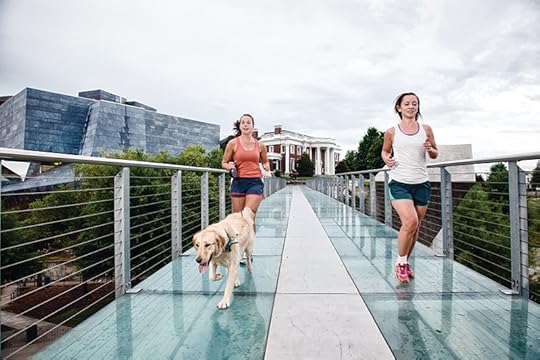
Running for Brews Chattanooga
View Larger Image
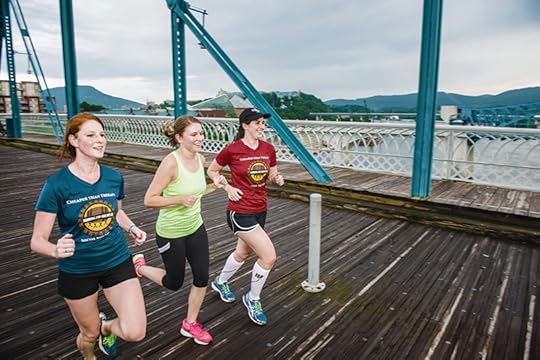
Running for Brews Chattanooga
View Larger Image

Running for Brews Chattanooga
View Larger Image
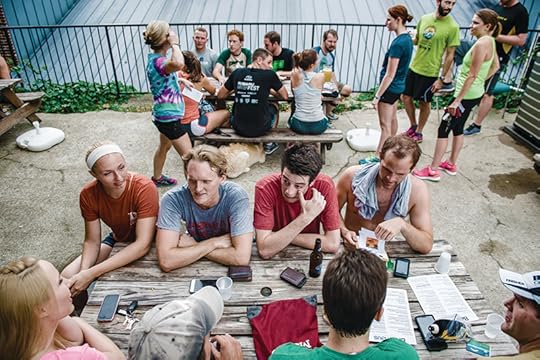
Running for Brews Chattanooga
View Larger Image
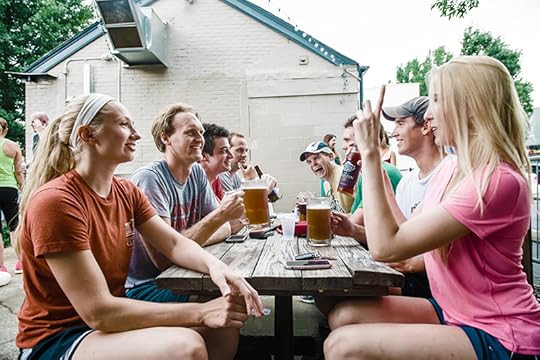
Running for Brews Chattanooga
View Larger Image

Running for Brews Chattanooga
View Larger Image

Running for Brews Chattanooga
View Larger Image
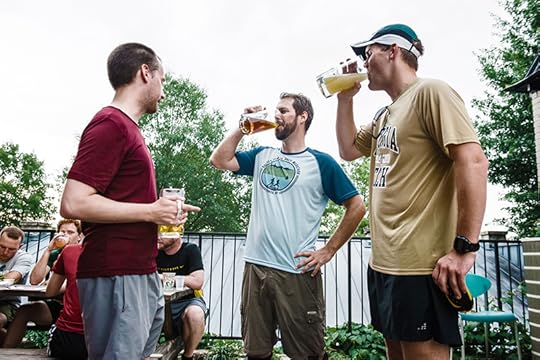
Running for Brews Chattanooga
View Larger Image
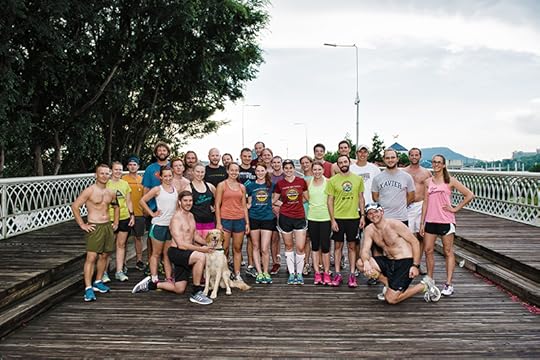
Running for Brews Chattanooga

More Galleries
The post Photos: Beer and Running in Chattanooga, Tenn. appeared first on Competitor.com.
Running On Beer

Members of the Running for Brews Chattanooga Chapter enjoy local craft beers and each other's company post-run. Photo: Ryan Gibson
The club that runs together, drinks together.
On a cloudy yet humid summer evening in Chattanooga, Tenn., a group of 30 runners gather in front of the Brewhaus Bar at 7 p.m. sharp. In the muggy heat, the crisp, foaming top of a craft ale on tap sounds preferable to running 3 miles around the neighborhood, but this is first and foremost a run club—the beer comes second.
The group in Chattanooga is a part of Running for Brews, one of the largest free social running clubs—with 16 locations across the nation—that incorporates beer drinking in their weekly group runs. It’s one of the many (and one of the most successful) beer running clubs that has capitalized on the growing trend of imbibing a few cold ones after a happy hour run.
“It’s interesting to watch one person come in and not know anyone, literally new to town, and they leave Running for Brews with new friendships,” says John McMahan, a former personal trainer, now the co-founder and events director for Running for Brews. “We’ve had three marriages through Running for Brews; my own relationship came about in RFB St. Pete. Meeting new people and making new friends—that’s what Running for Brews is.”
The first Running for Brews group was founded in 2010 in Dunedin, Fla., by Kevin Bupp and five other runners. Shortly after, through a mutual friend, Bupp met McMahan, who at the time was completing his MBA at the University of Tampa. One day (over beers, of course), Bupp asked McMahan if he wanted to start another RFB in Tampa Bay, Fla. Five years later it’s considered RFB’s benchmark location.
What had started with six members in Dunedin and seven in Tampa Bay has now grown to 10,000 members nationwide. Chapters such as the St. Pete and Satellite Beach locations in Florida see as many as 90 runners weekly.
RFB has expanded to several states and cities, mostly in the southern and eastern regions of the country, with groups as far west as Boulder, Colo., and Tempe, Ariz. But the club maintains a local, communal experience unique to the brand, no matter the city or size of the group.
“After we did Tampa, we started having a couple establishments approach us and be like, ‘Hey we’d love to have a running club come to our bar location.’ That’s when we really developed the business model and put together a game plan on how to start a Running for Brews in every city across the U.S.,” McMahan says.
From there RFB has grown organically. Each city has its own RFB Facebook page managed by an appointed organizer. Often, new cities are established either by organizers moving to a new city and vetting out an appropriate craft brew bar (an RFB requirement), or by having members vote for a city of interest.
What attributes to RFB’s success and others like it? Unlike more serious run clubs, beer running clubs focus on the social rewards of running. It doesn’t matter if you’re slow or fast, a marathoner or someone who hasn’t ran a mile since high school—these clubs put on a casual, non-intimidating atmosphere that welcomes newcomers and veterans of the sport alike.
“Everyone who comes to Running for Brews is a real runner, but they’re not dedicating their training to the max,” says McMahan, who started running when he joined RFB since its inception and has since run 5K, 10K, half marathon and half Ironman triathlon races. “It’s really cool to watch someone come to Running for Brews, do their first 5K, and then see them do a full marathon.”
Susanna Kirby, a 23-year-old medical scribe from Chattanooga, is one of those cases. A swimmer in high school and college, she had participated in a few 5K races before joining RFB, but wanted to push herself even further. Within a year, she had run three half marathons and recently completed her first half Ironman. Seven months after joining, she became RFB Chattanooga’s new organizer.
“I immediately fell in love with the group,” says Kirby, who has only missed four weeks worth of runs since becoming a member two years ago. “Running for Brews Chattanooga is the group you can work out with and the group you can unwind with after a stressful day. Our saying is that we are ‘cheaper than therapy.’”
In the final stretch, the group of 30 Chattanoogans—now sporadically banded in sweaty twos or threes along the course—make their way back to the bar. They run on the Chattanooga River Walk and turn around just beyond the University of Tennessee’s practice football field. They pick up the pace as the sun begins to set. A cold, rewarding, thirst-quenching brew awaits them at the finish.
RELATED: Photos: Beer and Running in Chattanooga, Tenn.
The post Running On Beer appeared first on Competitor.com.
Michele Gonzalez: 8 Tips to Survive Speed Work
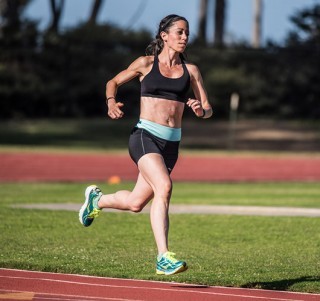
Like it or not, speed work is an integral part of any training plan – regardless if you are training for a 5K, 10K or marathon. For many runners, it’s the toughest and most dreaded workout of the week. It takes practice to learn to keep going when your body is hurting, when your breathing is heavy and when your mind is ready to quit. But pushing through the workouts during training helps develop fast-twitch muscles and equals race day speed. Just what you need to chase down your goals!
Here are eight tips to get you through your next speed session.
Warm Up and Stretch
Ensure you are giving your body time to warmup before starting the faster running. 10-15 minutes of easy running followed by dynamic stretching will help you begin the speed portion warmed up and ready to roll.
Focus on one Interval at a Time
It can be extremely disheartening to think about how many repeats you have left, especially at the beginning of a workout. Focus on the interval you are in and the blissful recovery period you will get after you finish that one set. Don’t think about the next one until it’s time.
Focus on Form
The more tired you are, the more likely your form is suffering. As the workout goes on, concentrate on basic form improvements – stand tall, kick off your toes, quick turnover and elbows in. Proper form will help you avoid injuries and run stronger and faster while also temporarily helping you forget the suffering.
Use Mantras
Don’t underestimate the mental boost of a motivating quote or mantra. Find one that speaks to you and repeat it in your mind when things start to get tough.
Here are a few of my favorites:
“Embrace the pain.”
“Clear your mind of can’t.” – Samuel Johnson
“You have a choice. You can throw in the towel, or you can use it to wipe the sweat off of your face.” – Gatorade ad
“You must do the thing you think you cannot do.” – Eleanor Roosevelt
Use Music
Find some upbeat, loud, motivating music that will get you pumped up and excited to work hard.
It’s Supposed to Hurt
Knowing – and accepting – that you will be in pain will help you deal with the uncomfortableness when it arrives. Speed work is “work” – it’s going to be hard and you are going to want to quit.
Picture Race Day
Envision yourself approaching the finish of your goal race. Picture yourself running hard and feeling strong. Use that image to keep you motivated during your workout.
It’s Worth It
Doing this workout and staying strong until the finish will pay off on race day. Work now to celebrate later.
The post Michele Gonzalez: 8 Tips to Survive Speed Work appeared first on Competitor.com.
Video: Dibaba Wins, Jenny Simpson Loses Shoe in 1,500m Final at Worlds
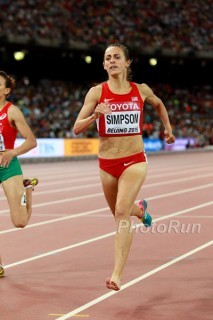
Jenny Simpson lost her shoe with about 700 meters to go and fell back. Photo: PhotoRun.net
(c) 2015 Race Results Weekly, all rights reserved. Used with permission.
BEIJING — Genzebe Dibaba saved her best running for the end for the women’s 1500m final at the IAAF World Championships.
The American duo of Shannon Rowbury and Jenny Simpson found themselves at the front of the pack after the gun, and decided to take it slowly. Very slowly. They ran the first 400 meters in 77 seconds, not even the pace of a good high school race.
“It just kind of happened that way,” said Rowbury, who would finish seventh.
The pace picked up after 400 meters, but it was with two laps to go that things got really interesting. Dibaba shot ahead, running a 57.3-second circuit from 800m to 1200m, taking Kenya’s Faith Kipyegon, Netherlands’ Sifan Hassan and Ethiopia’s Dawit Seyaum with her.
But Simpson, the 2011 world champion, could not join the battle. She had her left shoe stepped on, pulling it off. She was forced to run the last 700 meters of the race with one shoe.
“I was jogging along with everyone else, then I kind of paid a price for it,” said Simpson, who finished second to last, ripping the skin off part of the bottom of her right foot. “Dibaba made a big move and I got shoved into traffic. My shoe even ripped. I got spiked bad enough that it totally ripped when it came off. I was just unlucky.”
But not Dibaba. She did not let up, running an eye-popping 1:57 for the final 800m to finish in the slowest winning time ever at these championships: 4:08.09. Kipyegon got second (4:08.96) and Hassan third (4:09.34). Rowbury finished seventh.
“As you know, my preparation was very good,” Dibaba said through a translator. “I think that I did the right thing, that my expectations were right.”
Dibaba is not finished competing here. On Thursday morning, she’ll line up for the preliminary round of the 5000m, where she is also a favorite to win gold.
“The history is two golds from my sister,” she said, referring to big sister Tirunesh Dibaba who, in this same stadium, won gold medals at both 5000m and 10,000m at the 2008 Olympics. “Then my mind is made up. I have to do both.”
Elsewhere at Worlds, David Rudisha claimed gold in the 800m. The 2012 Olympic champion and world-record holder took the field through 400 meters in a pedestrian 54.17—unlike his usual strategy of going hard from the start—before leaving his competitors behind in the second half. He won the race in 1:45.84
The post Video: Dibaba Wins, Jenny Simpson Loses Shoe in 1,500m Final at Worlds appeared first on Competitor.com.
August 24, 2015
Liliya Shobukhova Allowed to Race Again—But Who Will Have Her?

Liliya Shobukhova will be able to race again. The question, will any race take her?
The disgraced Russian marathoner officially lost her 2009, 2010 and 2011 Chicago Marathon wins, as well as her 2010 London Marathon title, after it was discovered through her biological passport that she was doping during that period. However, this week the World Anti-Doping Agency confirmed that Shobukhova’s 3-year, 2-month ban for doping was reduced by seven months due to her cooperation in helping uncover other athletes.
“She accepted from the outset that she had committed an anti-doping rule violation,” WADA said in a statement. “The information and documentation provided by Ms. Shobukhova has been of substantial value in uncovering and investigating anti-doping rule violations committed by other individuals, including athlete support personnel.”
Her reduced ban expired on Sunday, meaning she’s allowed to compete again.
However, the World Marathon Majors has a lifetime doping ban, so don’t expect Shobukhova, 37, to be back in any of those races. The London Marathon confirmed as much, releasing a statement saying “Our zero tolerance policy is unaltered. We believe there should be no place in our sport for people who have cheated, no matter how much assistance they give after they have been caught.”
Not only that, but both the London Marathon and Chicago Marathon said earlier this month that they would be going after Shobukhova to recoup prize money from the races that took place while she was cheating.
The post Liliya Shobukhova Allowed to Race Again—But Who Will Have Her? appeared first on Competitor.com.
First Certified Running Guide Dog Graduates from Training
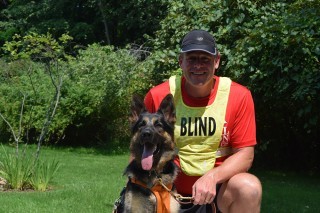
During Klinger's six-month running guide training, Richard Hunter also trained with the 2-year-old German shepherd for three weeks at the Guiding Eyes for the Blind facility in New York. Photo: Courtesy of Guiding Eyes for the Blind
Meet Klinger, a 2-year-old German shepherd and the first ever certified running guide dog. This past Saturday marked Klinger’s official graduation from the new Running Guides Program at Guiding Eyes for the Blind, an international nonprofit based in Yorktown Heights, N.Y., that provides guide dogs to those with vision loss.
Still in its developmental phase, the Running Guides Program’s mission aims to increase independence for visually impaired athletes.
“This pilot program is focusing on the feasibility of selecting and specially training dogs for their partners on approved exercise routes prior to being issued in class,” says Benjamin Cawley, class supervisor for Guiding Eyes for the Blind. “We will continue to build our techniques and hope to one day shift from an experimental pilot to a fully-implemented program.”
So far, the experiment has been a success. After passing six months of running guide-specific training—including three weeks of training with his new owner, Richard Hunter, a 48-year-old three-time Boston marathoner and the second visually impaired triathlete to complete Ironman in less than 12 hours (11 hours and 55 minutes)—Klinger is on to the next phase of the program: becoming an integral part of Hunter’s life.
In 1989, shortly after being commissioned as a second Lieutenant in the US Marine Corps, Hunter was diagnosed with Retinitis Pigmentosa, a degenerative eye disease that leads to eventual vision loss. Since then he’s not only become an avid endurance sport athlete, but also an active figure for visually impaired runners and triathletes across the nation. He’s a coordinator for the USABA National Marathon Championships held each December in conjunction with the California International Marathon in Sacramento, and more recently he founded United in Stride, a North American online database resource that matches volunteer sighted guides with blind runners within their zip code.
He’s also the first person to suggest starting a canine Running Guides Program.
A couple years ago, Hunter was struck by a car while training for Ironman Lake Tahoe with his triathlon guide. He flew off the back of the tandem bicycle headfirst through the windshield of the car, splitting his helmet in half. The damages: A couple facial fractures, a broken neck, several lacerations and a severe concussion.
“This was like an exclamation mark on my safety for myself and for my family,” says Hunter, recalling the three months he spent in a neck brace after leaving the hospital and requiring a hospital bed in his living room for a month.
Luckily, the accident didn’t result in any spinal cord injuries and Hunter was able to return to outdoor running while he recovered. He finished the California International Marathon five months after the accident.
“At the time I had some limited vision, and even though I have a lot of running guides I still have to run six days a week. Some of my slower and shorter runs, I’d run myself,” Hunter says. “I’ve ran into poles, tripped over steel cables, ran off the sidewalks, had some near misses and not always saw everything coming at me despite going slow.” Something needed to change.
Thus, about nine months following the accident Hunter found himself waiting at the start line of the Boston Marathon with a group of visually impaired runners, including the chief executive officer of Guiding Eyes for the Blind, Thomas Panek, and asked him a question.
“I asked Thomas, ‘You’re a CEO of a guide dog school, you have my eye condition, you’re a marathoner and you also have a guide dog, what do you think about jogging with a guide dog?”
Fast-forward to Klinger’s graduation ceremony this past weekend and it’s clear Hunter’s mere suggestion became a reality.
In addition to Klinger’s regular guide work training, his running guide curriculum consisted of running three days per week, starting with 1-mile runs then slowly building his stamina up to 5K and 10K distances. He’s logged more than 200 miles.
“Klinger learned how to responsibly guide his handler in various environments, anywhere from a small town back road with no sidewalks, all the way to the big city environment of Manhattan, ” says Jolene Hollister, Klinger’s primary trainer at Guiding Eyes for the Blind. “He even guided me on two blindfolded runs to demonstrate his ability to safely guide at a running pace.”
Having passed all the initial tests and attended graduation, Klinger now joins Hunter in his home city of Sacramento, Calif. The next step is to ease Klinger into the new 10K and half-mile loops Hunter runs regularly within his neighborhood. A trainer from Guiding Eyes for the Blind will also be arriving on Wednesday, Aug. 26, to assist with the transition and to ensure the process is executed safely for both Klinger and Hunter.
Klinger will not be guiding Hunter in races due to the mass crowds of people running in the same direction, a distraction that can pose a risk to both guide dog and visually impaired runner. However, Klinger is undoubtedly Hunter’s most loyal running guide and companion on and off the road, changing his life for the better.
“Klinger loves to run and he’s an outstanding guide dog. I have full confidence in him,” Hunter says. “And the best thing about having Klinger as a running buddy is that he can’t cancel on me last minute.”
The two are beginning their training for this year’s California International Marathon.
The post First Certified Running Guide Dog Graduates from Training appeared first on Competitor.com.
How to Develop Speed for a Fast 5K
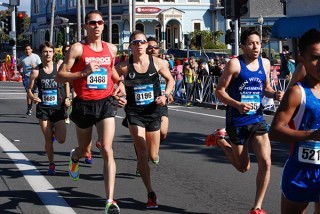
5Ks like the Carlsbad 5000 allow for a good blend of speed and endurance.
The 5K is a complex—but thrilling—race. It’s short enough to require a lot of speed, but long enough to certainly be a distance runner’s event.
Ignore the speed necessary to run well and you won’t have that “higher gear” to finish strong.
Skip the foundational endurance during training and you’ll crash and burn in the final mile.
So what does sound training look like for runners targeting a fast 5K? There are three main ingredients:
Endurance (but more specifically, high-end endurance)
Speed development (5K pace, but also faster paces to stimulate muscular strength and the central nervous system)
Race-specific fitness (can you run about 3 miles worth of intervals at goal 5K pace during training?)
When you start planning a season, the focus must be on opposite ends of the speed spectrum: endurance and speed development.
As you get closer to the goal race, workouts start to look more similar to the 5K itself. In other words, they get more “specific” to the demands of the race.
Let’s discuss each element of training.
The post How to Develop Speed for a Fast 5K appeared first on Competitor.com.
Ryan Hall's Blog
- Ryan Hall's profile
- 21 followers



